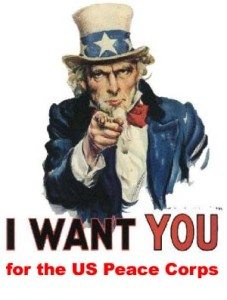 Want to see the world and experience other cultures? The Peace Corps may be right for you. Each year, approximately 15,000 to 18,000 Americans apply to serve. While locales vary from year to year, present opportunities range from the islands of Jamaica and the Dominican Republic, to the mountains of Nepal and Peru. Volunteers serve in China, Madagascar, South Africa, and 50 other countries around the world.
Want to see the world and experience other cultures? The Peace Corps may be right for you. Each year, approximately 15,000 to 18,000 Americans apply to serve. While locales vary from year to year, present opportunities range from the islands of Jamaica and the Dominican Republic, to the mountains of Nepal and Peru. Volunteers serve in China, Madagascar, South Africa, and 50 other countries around the world.
Since its founding in the midst of the Cold War between the United States and the Soviet Union, the Peace Corps has become the best-known volunteer-abroad program available to American citizens. However, that doesn’t mean it hasn’t had its share of critics: 1960 presidential candidate Richard M. Nixon claimed it would become a “haven for draft dodgers,” while an editorial in the Harvard Crimson said that “the Peace Corps is arrogant and colonialist in the same way as the government of which it is part.”
However, a 2011 Rasmussen Report survey indicated that almost two-thirds of adult Americans now have a favorable opinion of the Peace Corps. And a 2011 survey of volunteers run in part by the Peace Corps found that the program has had a very positive effect on those who sign up for it:
90% rated their experience as excellent or very good.
92% said it changed their lives.
98% would recommend the Peace Corps to their child, grandchild, or other close family member.
Over the past 50-plus years, young Americans have joined the organization in droves seeking to help others, learn the ways and languages of different cultures, and gain an advantage in the job market when they return.
Origin of the Peace Corps
In 1961, the world’s superpowers were in the midst of the Cold War. The Soviet Union and the United States faced off in Berlin, resulting in the Soviets building a wall separating East and West Germany. A CIA-sponsored military invasion to overthrow Cuba’s President Fidel Castro ended with the disastrous Bay of Pigs invasion and set the table for another face-off in 1962 with the Cuban Missile Crisis. Halfway around the world, Southeast Asia was considered the pivotal point in the war between communism and democracy, leading President John F. Kennedy to commit special forces, military equipment, and financial support to South Vietnam.
While the Peace Corps mission is to “promote world peace and friendship,” the competition between superpowers was a major factor in its creation. President Kennedy recognized that the Soviets “had hundreds of men and women, scientists, physicists, teachers, doctors, engineers, and nurses…prepared to spend their lives abroad in the service of world communism.” Kennedy wanted a counter-program that involved “Americans more actively in the cause of global democracy, peace, development, and freedom.”
As a consequence, the Peace Corps was founded by executive order on March 1, 1961, and authorized by Congress later that year. The first group of 51 volunteers arrived in Ghana to begin their service. By the end of 1961, more than 500 volunteers were serving in nine host countries: Chile, Colombia, Ghana, India, Nigeria, the Philippines, St. Lucia, Tanzania, and Pakistan. By 2015, almost 220,000 Americans had served in 140 separate countries.
Read more . . .

